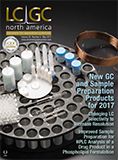Improved Methods for Analyzing Wastewater and Sediments
LCGC North America
Eric Nelson discusses methods for analyzing halogenated transformation products of pharmaceuticals and other contaminants.
When wastewater is treated at publicly owned treatment plants (POTW), the utilities are required to ensure that the discharged effluent poses no threat to human health or the environment. Many of the tests required by effluent discharge permits include tests for well characterized priority organic pollutants such as volatile organic compounds, banned organochlorine pesticides, and polycyclic aromatic hydrocarbons. Chlorine disinfection processes can also lead to the creation of uncharacterized halogenated or brominated byproducts. In this interview, Eric Nelson of the Sanitation District of Los Angeles County, California, discusses studies his research group has carried out to analyze contaminants of emerging concern (CECs) and some halogenated transformation products of pharmaceuticals and personal care products (PPCPs) and endocrine-disrupting compounds (EDCs) in treated wastewater. Additionally, he has investigated the use of the QuEChERS (quick, easy, cheap, effective, rugged, and safe) sample preparation method for measuring CECs in sediments.
You conducted a study in which you examined the diurnal variability in the concentrations of endocrine-disrupting compounds and pharmaceuticals and personal care products in effluent from a wastewater treatment facility (1). Why did you feel it was important to study such variability?
Our laboratory has been proactively investigating CECs for almost 13 years. The water we treat and discharge is highly regulated, but CECs do not fall under any regulation because until a few years ago no one knew they were there. When I got involved in the project, we and most other researchers were still trying to figure out which compounds were the most detected, the most refractory, or of the most potential concern. The list continues to evolve. As we developed our analytical methods, we noticed that our grab samples from the adjacent wastewater treatment plant had concentrations of certain analytes that varied significantly. We didn’t know if the inconsistencies were related to our lab work or to the treatment plant. As our work progressed, we realized that the concentrations of many CECs were lower in the morning samples than in afternoon samples. At the time, there was only one published article that even hinted at daily cycles. It was fairly simple to set up an automated sampler to collect samples each hour. After we worked up all the data, we were surprised at how regular and discernible the cycles were for some CECs. Peak effluent concentrations occurred between 4:00 and 6:00 pm daily. Additionally, we were surprised that some CECs didn’t change during the day or between days. We still haven’t been able to explain that finding.
An understanding of diurnal variations is important if any modeling or assessments of CEC environmental loadings are conducted. For example, the exposure of aquatic life to peak CEC concentration may be more significant than if only the mean daily concentration is assumed.
What sample preparation steps did you follow?
In that study, we used an automated solid-phase extraction (SPE) system (the AutoTrace, made by Caliper and now owned by Thermo Scientific) with polymeric cartridges (both Waters HLB and Phenomenex Strata-X). Depending on the analyte, we extracted either 200 or 500 mL of sample. A 10-mL volume of extract was then reduced to 1 mL using dry air.
What types of standards did you use, and why?
The analytical standards we used for this work were all commercially available. We tried to obtain a second source or lot to verify the primary standard. Isotope-labeled analog standards are essential for accurate quantitation in a complex matrix like wastewater or surface water. Ion suppression effects in the mass spectrometer’s source (a big issue for complex matrices like wastewater) can be normalized by using labeled internal standards. These standards can be a little hard to find and are expensive, but make the data so much more reliable.
Why did you use triple-quadrupole mass spectrometry (MS) detection for this study?
For complex matrices like wastewater or surface water, using a triple-quadrupole MS system will filter out many of the interferences that reduce the sensitivity and increase reporting limits. I don’t think that these analyses would be very reliable if this work was done on a single-quadrupole system.
You conducted a study of the occurrence of halogenated transformation products of pharmaceuticals and personal care products in treated wastewaters from southern California (2). First, how did you select the compounds that you wanted to analyze?
I heard a talk at a SETAC [Society of Environmental Toxicology and Chemistry] conference about the formation and toxicity of one halogenated pharmaceutical. The talk was by Daryl Bulloch, then a graduate student at the University of California-Riverside. After talking with Bulloch and his advisors, we decided to collaborate on a project looking for these compounds in wastewater. Bulloch had already selected a few compounds with aromatic ring structures that could be predictably halogenated by chlorine disinfection. I suggested several others with similar structures that I knew were in our plant water.
Can you please briefly describe the analytical approach used in this study?
We already had reliable, validated methods in place for measuring parent CECs, so we added the new, halogenated analytes to the existing methods. It worked very well with only a few exceptions. One analyte was not retained by the SPE cartridge, so we had to lower the pH of the sample before extraction.
Why did you synthesize isotope-labeled internal standards for the study?
The more isotope-labeled internal standards we used, the more reliable our results were. Some of the samples we looked at were unfiltered secondary (biological treatment) effluent. The labeled internal standards compensated for suppression and recovery issues, and gave us the most reliable results. You assume that whatever happens to the internal standard also happens to the analyte.
Bulloch started with commercially available isotope-labeled standards, halogenated them (in deionized water with NaOCl), separated and purified them, and then ran assays to test for confirmation and purity. Without these standards, I feel that all our values would be just guesses.
What aspects of the method used in this study were different from those used in similar studies?
The unique parts of this study were that we used synthesized internal standards to make it more accurate, that we looked at a lot of different treatment plants, and that we looked at more compounds than other studies.
What results did you see in this study? In particular, what did you see with regard to the role of secondary and tertiary treatment in terms of the formation or elimination of halogenated transformation products?
The first thing we noticed was that some compounds were much more reactive than others. Salicylic acid was clearly the most reactive and had the highest concentrations of halogenated disinfection by-products. The tertiary treatment plants were smaller and all have extra treatment processes, so removing more of the parent compounds reduced the amount of halogenated transformation products. Another difference between the secondary and tertiary treatment plants was that the plants using only secondary treatment had more brominated by-products. The elevated bromination is likely due to these particular treatment plants receiving more industrial wastes than the tertiary plants, which primarily receive municipal sewage. Industrial wastewater containing brine is a potential source of bromide.
You have also done work analyzing the use of the QuEChERS sample preparation method for measuring contaminants of emerging concern in sediments. First, what compounds were you analyzing in this study?
We initially wanted to find a technique to evaluate our CEC suite in sediments near the ocean outfall for water being treated by the Los Angeles County Sanitation District. Because we were aware of possible CECs in the discharges, we were curious whether any of these might be accumulating in the sediments.
Why did you decide to apply QuEChERS to this type of analysis?
There was already an accelerated solvent extraction (ASE) unit in our lab used for sediment extraction and analysis of priority pollutants (especially DDTs). Our initial work with ASE left us thinking that there was too much “junk” in our extracts, requiring additional time-consuming cleanup steps. My colleague Syljohn Estil proposed and developed a method using QuEChERS. The extraction was very efficient for most of the CECs. We were able to incorporate most of the analytes for what are three separate extractions in liquid samples (steroids, PPCPs, and pyrethroid pesticides) into one QuEChERS extraction. The same autosampler vial has multiple (up to four) analyses run from it. Obviously, some of the CECs partition to the aqueous fraction, but if these compounds favor the aqueous phase over solvent, then they were likely not in sediments to start with.
How did you modify the standard QuEChERS approach for the needs of this application?
Because QuEChERS extracts cannot capture 100% of the initial solvent volume and need recovery compensation, isotope-labeled internal standards are essential for reliable quantification of sediment having more matrix suppression-even more than for liquid samples. We noticed immediately that the QuEChERS extractions were getting very hot-about 50–60 °C. At this elevated temperature we felt that some of the deuterium on the labeled standards might undergo proton exchange (losing the label) and affect the accuracy of quantitation. By reducing the amount of anhydrous magnesium sulfate in the extraction we lowered the temperature but still maintained a good separation between solvent and aqueous phases. The only problem that we encountered was the unexpectedly high concentrations of 4-nonylphenol (one of our analytes) in several of the reagents. We are still working to reduce this artifact
What are your future plans in terms of using QuEChERS for this type of analysis?
We are currently developing a method for polyfluorinated compounds (such as PFOS and PFOA) from the same extraction described earlier. Additionally, we would like to examine some currently used pesticides. Eventually, QuEChERS could be used on biological tissue to study bioaccumulation of CECs.
References
- E.D. Nelson, H. Do, R.S. Lewis, and S.A. Carr, Environ. Sci. Technol. 45, 1228–1234 DOI: 10.1021/es102452f (2011).
- D.N. Bulloch, E.D. Nelson, S.A. Carr, C.R. Wissman, J.L. Armstrong, D. Schlenk, and C.K. Larive, Environ. Sci. Technol. 49, 2044−2051, DOI: 10.1021/es504565n (2015).

Eric Nelson went to Haverford College majoring in chemistry, then received a MS in marine, estuarine, and environmental sciences from the University of Maryland. His research focused on fate and transport of PAHs, PCBs, and pesticides in the Chesapeake Bay. After graduate school, he continued his fate and transport work under Steve Eisenreich at Rutgers University, looking for the same compounds in the air and water throughout New Jersey as well as New York harbor. Nelson moved to southern California in 2000, to work for the consulting company Ecology and Environment, Inc. The consulting was predominantly subcontract work for the US EPA that included air monitoring in a cancer cluster in the California Central Valley, support for Superfund removals, and emergency responses. Since 2004, he has worked as a research chemist for the Sanitation District of Los Angeles County at their San Jose Creek Water Quality Laboratory in Whittier, California. Nelson’s current research focuses on analytical methods, fate and transport of contaminants of emerging concern such as pharmaceuticals, personal care products, hormones, and other endocrine-disrupting compounds in our wastewater. More recently, his research group has examined halogenated disinfection byproducts and CECs in sediments.
